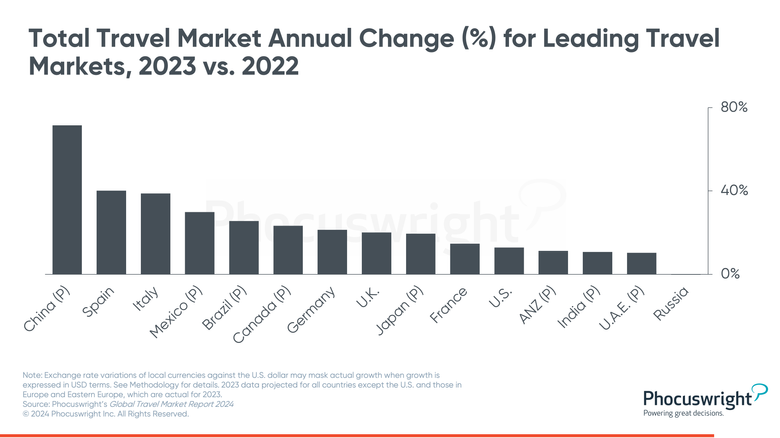The global travel industry is back on track, surging by 24%
in 2023 to hit $1.5 trillion. North America, Asia Pacific and Western Europe continue
to lead in terms of market size.
With $476 billion in gross bookings in 2023, the United States boasts the world’s largest travel market – more
than three times the size of China, the second-largest market.
According to Phocuswright’s latest travel research report, Global Travel Market Report 2024, the top 15 markets in 2023 closely resemble those of 2019, exhibiting some shifts in their rankings and the addition of a newcomer.
Brazil joined the list, displacing Scandinavia as the 15th largest market in 2022. The United Arab Emirates, with total travel gross bookings of $44 billion in 2023, accounted for over half of the Middle East’s travel market and occupied the seventh position in the list. Notably, Russia’s total travel bookings reached a projected $27 billion in 2023, only about three-fourths of its 2019 levels. The invasion of Ukraine and subsequent economic sanctions have impeded Russia’s recovery from pandemic downturns, leading to a five-place drop to the 14th position on the list from 2019 to 2023.
When expressed in U.S. dollars, all top 15 travel markets, except Russia, experienced year-over-year growth in 2023. Among these, five European markets stood out, benefiting from the euro’s gain against the U.S. dollar.
Spain led the pack with a remarkable 40% growth when measured in U.S. dollars. Additionally, in U.S. dollar terms, Italy, Germany, the United Kingdom and France all achieved double-digit gains.
Notably, China’s travel market surged by 72%. Meanwhile, Mexico and Brazil were the top markets in Latin America in 2023.
Learn more!
Global Travel Market Report 2024 provides
comprehensive travel market sizing and projections from 2019-2026, including
analysis of key segments, trends and distribution dynamics for six regions:
North America (U.S. and Canada), Asia Pacific (APAC), Europe, the Middle East,
Latin America (LATAM) and Eastern Europe.












